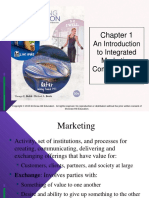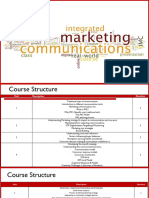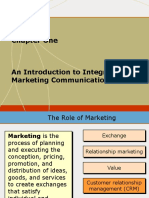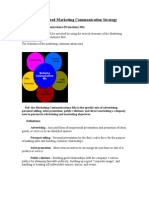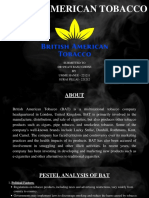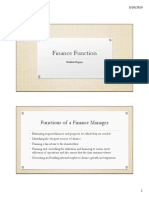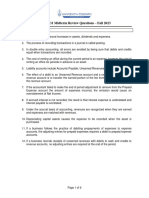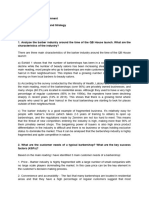An Introduction to
Integrated Marketing
Communications
© McGraw-Hill Education. All rights reserved. Authorized only for instructor use in the classroom. No reproduction or further distribution permitted without the prior written consent of McGraw-Hill Education.
� Learning Objectives
LO1 Describe the role of advertising and other
promotional elements in marketing.
LO2 Discuss the evolution of the integrated
marketing communications (IMC) concept.
LO3 Explain the increasing value of the IMC
perspective in advertising and promotional
programs.
LO4 Identify the elements of the promotional mix.
LO5 Describe the steps in the IMC planning process.
© McGraw-Hill Education.
� The Role of Marketing
▪ Marketing: Activity, set of institutions, and processes
for creating, communicating, delivering and
exchanging offerings that have value for:
• Customers, clients, partners, and society at large
▪ Exchange: Involves parties with:
• Something of value to one another
• Desire and ability to give up something to the other
party
• Way to communicate with each other
© McGraw-Hill Education.
� The Role of Marketing
▪ Value: Customer’s perception of benefits of a
product or service against the costs of acquiring and
consuming it
✓ What you get – What you give up
✓ Benefits are functional, experiential, and/or
psychological
© McGraw-Hill Education.
� The Role of Marketing
▪ The 4 Ps: product, price, place, and promotion
To develop an effective marketing mix, marketers must:
▪ Be knowledgeable about the issues and options of
each element of the mix
▪ Know how to combine the elements to form an
effective marketing program
▪ Analyze the market and use the data to develop the
marketing strategy and mix
© McGraw-Hill Education.
� Marketing Communication Mix
▪ Marketing communication is a single tool?
▪ The marketing communication mix consist of the
specific blend of advertising, public relations, personal
selling, and direct-marketing tools that the company
uses to persuasively communicate customer value and
build customer relationships
© McGraw-Hill Education.
� The Growth of Marketing Communication
▪ Consumers are changing
▪ Marketing strategies are changing
▪ Changing communications technology
© McGraw-Hill Education.
� Integrated Marketing Communications (IMC)
▪ Integrated marketing communications is the
integration by the company of its communication
channels to deliver a clear, consistent, and compelling
message about the organization and its brands
© McGraw-Hill Education.
� Integrated Marketing Communications (IMC)
© McGraw-Hill Education.
� Integrated Marketing Communications (IMC)
© McGraw-Hill Education.
� Integrated Marketing Communications (IMC)
1. Coordinate various promotional elements and other
marketing activities that communicate with a firm’s
customers
2. Recognizes the added value of a comprehensive plan
that:
• Evaluates the strategic roles of a variety of communication
disciplines
• Combines the disciplines to provide clarity, consistency,
and maximum communications impact
3. Ensures all marketing and promotional activities project
a consistent, unified image
© McGraw-Hill Education.
� Integrated Marketing Communications (IMC)
A Contemporary Perspective of IMC
▪ IMC is recognized as a business process that helps
companies identify the most appropriate and effective
methods for communicating and building relationships
with customers and other stakeholders
▪ Goal: Generate short-term financial returns and build
long-term brand and shareholder value
▪ Views IMC as ongoing strategic business process rather
than just tactical integration of various communication
activities
© McGraw-Hill Education.
� Integrated Marketing Communications (IMC)
Reasons for the Growing Importance of IMC: reasons
why marketers are adopting the IMC approach
▪ Strategically integrates various communications functions
▪ Develops more efficient and effective marketing
communications programs
▪ Avoids duplication and takes advantage of synergy among
promotional tools
▪ Adaptation by marketers to a changing environment
© McGraw-Hill Education.
� Integrated Marketing Communications (IMC)
The Role of IMC in Branding
▪ Helps develop and sustain brand identity and equity
▪ Recognizes the need for companies to connect with
consumers based on trust, transparency, and authenticity
▪ Sustainability: development that meets the needs of the
current generation without compromising the ability of
future generations to meet their needs
✓Companies are addressing sustainability by carefully
examining the social and environmental impacts of their
marketing strategies.
© McGraw-Hill Education.
� The Promotional(Communication) Mix: The Tools for IMC
▪ Tools that accomplish an organization’s communication
objectives
▪ Promotion: Coordination of all seller-initiated efforts to:
– Set up channels of information and persuasion
– Sell goods and services or promote an idea
© McGraw-Hill Education.
� The Promotional Mix: The Tools for IMC
▪ Advertising: Any paid form of nonpersonal
communication:
– About an organization, product, or service
– With an idea from an identified sponsor
▪ The nonpersonal component:
– Involves mass media / digital
– Message is transmitted to large groups of individuals
– No opportunity for immediate feedback
© McGraw-Hill Education.
� The Promotional Mix: The Tools for IMC
▪ Benefits of Advertising
– Most cost-effective way to reach large numbers of
consumers
– Builds brand equity by influencing consumers’ perceptions
© McGraw-Hill Education.
� Advertising to Consumer Markets
▪ National advertising
• Done on a nationwide basis or in most regions of the
country
▪ Retail/local advertising: encourage consumers to:
• Shop at a specific store
• Use a local service
• Primary-demand advertising: stimulates demand for the
general product class or entire industry
• Selective-demand advertising: creates demand for a
specific company’s brands
© McGraw-Hill Education.
� Advertising to Business and Professional Markets
▪ Business-to-business advertising
– Targets individuals who buy or influence the purchase of
industrial goods or services for their companies
▪ Professional advertising
– Targets professionals(doctors, lawyers, engineers,
professors) encouraging them to use a company’s product
in their business operations
▪ Trade advertising
– Targets marketing channel members (wholesalers,
retailers), encouraging them to stock, promote, and resell
the manufacturer’s branded products to their customers
© McGraw-Hill Education.
� The Promotional Mix: The Tools for IMC
▪ Direct Marketing: Communicating directly with
target customers to generate a response and/or a
transaction
▪ Involves:
– Database management
– Direct selling
– Telemarketing
– Direct-response advertising
• Encourages the consumer to purchase directly from the
manufacturer
© McGraw-Hill Education.
� The Promotional Mix: The Tools for IMC
▪ Omnichannel retailing: Companies sell their
products through multiple distribution channels
including retail stores, online and mobile apps.
© McGraw-Hill Education.
� The Promotional Mix: The Tools for IMC
▪ Digital/Internet Marketing
– Interactive media
• Allow users to participate in and modify the form and
content of the information they receive in real time
– Social media
• Online means of communication and interactions used
to create, share, and exchange content
– Mobile marketing
• Messages delivered are specific to a consumer’s
location or consumption situation
© McGraw-Hill Education.
� The Promotional Mix: The Tools for IMC
▪ Advantages of Digital/Internet Marketing
– Interactive nature
– Capability to precisely measure the effects of advertising
and other forms of promotion
© McGraw-Hill Education.
� The Promotional Mix: The Tools for IMC
▪ Sales Promotion: Marketing activities that provide
extra value or incentives to the:
• Sales force
• Distributors
• Ultimate consumer
▪ Aids in stimulating immediate sales
© McGraw-Hill Education.
� The Promotional Mix: The Tools for IMC
▪ Categories of sales promotion
• Consumer-oriented
- Targeted to the ultimate user
- couponing, sampling, premiums, rebates, contests,
sweepstakes, point-of-purchase
• Trade-oriented
- Targeted toward wholesalers, distributors, and retailers
- Allowances, price deals, sales contests, trade shows
© McGraw-Hill Education.
� The Promotional Mix: The Tools for IMC
▪ Reasons for Increased Emphasis of Sales Promotion
– Declining brand loyalty
– Increased consumer sensitivity to promotional deals
© McGraw-Hill Education.
� The Promotional Mix: The Tools for IMC
▪ Public Relations
– “A strategic communication process that builds mutually
beneficial relationships between organizations and their
publics”
– Broader objective than publicity
– Goal : Establish and maintain a positive image among
various publics
– Evaluates public attitudes
– Identifies policies and procedures of an individual or
organization with the public interest
© McGraw-Hill Education.
� The Promotional Mix: The Tools for IMC
▪ Personal Selling: Person-to-person communication in
which seller attempts to assist and/or persuade
prospective buyers to:
– Purchase a company’s product
– Act on an idea
▪ Allows seller to tailor messages to the customer’s specific
needs or situation
▪ Involves immediate and precise feedback
© McGraw-Hill Education.
� The IMC Planning Process
▪ Integrated marketing communications management
• Planning, executing, evaluating, and controlling the
use of the promotional-mix elements to effectively
communicate with target audiences
▪ Integrated marketing communications plan
• Developing, implementing, and controlling an
organization’s IMC program
© McGraw-Hill Education.
� IMC
Planning
Model
� The IMC Planning Process
▪ Marketing Plan: Describes overall marketing
strategy and programs for an organization and
includes:
– Detailed situation analysis
– Review of the overall marketing plan and objectives
– understanding of market opportunities, competition, and
market segments
– Selection of target market(s) and plans for the four
elements of the marketing mix
– Program for implementing the marketing strategy
– Process for monitoring and evaluating performance
© McGraw-Hill Education.
� The IMC Planning Process
▪ Internal Analysis: Assesses the firm and relevant
areas involving the product/service offering
✓Assessment of:
• Capability to develop and implement promotional
program
• Brand image and implications for promotion
• A product’s relative strengths and weaknesses
✓Reviews previous promotional programs and results
© McGraw-Hill Education.
� The IMC Planning Process
▪ Opportunity Analysis
– Market opportunities
• There are favorable demand trends
• Customers’ needs and opportunities are not being
satisfied
• Firm can compete effectively
© McGraw-Hill Education.
� The IMC Planning Process
▪ External Analysis: Focuses on characteristics of a
firm’s customers, market segments, positioning
strategies, and competitors
– Customer analysis
– Competitive analysis
– Environmental analysis
© McGraw-Hill Education.
� The IMC Planning Process
▪ Competitive Analysis
– Analyzing the competition in the marketplace and
searching for a competitive advantage
• Competitive advantage: Attributes that give a firm an
edge over competitors
– Better quality products
– Superior customer service
– Low production costs and lower prices
– Dominating channels of distribution
– Advertising
© McGraw-Hill Education.
� The Target Marketing Process
© McGraw-Hill Education.
� The Target Marketing Process
▪ Identifying Markets
– Marketer identifies the specific needs of groups of people
(or segments)
– Selects one or more of these segments as a target
– Isolates consumers with similar lifestyles, needs, and the
like
– Increased marketer’s knowledge of consumers’ specific
requirements
© McGraw-Hill Education.
� The Target Marketing Process
▪ Market Segmentation
– Dividing a market into distinct groups with common needs,
who respond similarly to a marketing situation
– Customer characteristics segmentation criteria
• Geographic: Dividing the market on the basis of region,
city size, metropolitan area, and/or density
• Demographic: Dividing the market on the basis of age,
sex, family size, marital status, etc.
© McGraw-Hill Education.
� The Target Marketing Process
▪ Market Segmentation
• Socioeconomic: Dividing the market on the basis of
income, education, or occupation
• Psychographic: Dividing the market on the basis of
personality, lifecycles, and/or lifestyles
• Behavioristic: Dividing consumers into groups
according to their usage, benefits, loyalties, or buying
responses to a product
© McGraw-Hill Education.
� The Target Marketing Process
▪ Selecting a Target Market
– Determine how many segments to enter
• Utilizing market coverage alternatives
– Determine which segments offer the most potential
• Selecting the most attractive segment
© McGraw-Hill Education.
� The Target Marketing Process
▪ Selecting a Target Market
– Market Coverage Alternatives
• Undifferentiated marketing
– Ignoring segment differences and offering just one
product or service to the entire market
• Differentiated marketing
– Involves marketing in a number of segments,
developing separate marketing strategies for each
• Concentrated marketing
– Selecting a segment and attempting to capture a
large share of this market
© McGraw-Hill Education.
� The Target Marketing Process
▪ Market Positioning
– Positioning: Fitting a product or service to one or more
segments of the broad market to make it unique within the
marketplace
– Approaches
• Focusing on the consumer: Linking the product with the
benefits the consumer will derive
• Focusing on competition: Positions the product by
comparing the benefit it offers versus the competition
© McGraw-Hill Education.
� Developing the Marketing Planning Program
▪ Product Decisions
– Branding
• Builds and maintains brand awareness and interest
• Develops and enhances attitudes toward the company
or product
• Builds relationships between the consumer and the
brand
© McGraw-Hill Education.
� Developing the Marketing Planning Program
▪ Product Decisions
– Packaging
• Traditionally, the package provided functional benefits:
economy, protection, and storage
• Role and function have changed due to:
– Self-service emphases of many stores
– More buying decisions at point of purchase
• First impressions matter
– Often first exposure to product
© McGraw-Hill Education.
� Developing the Marketing Planning Program
▪ Price Decisions
– Price variable: Refers to what the consumer has to give in
exchange for a purchase
– Factors that determine price
• Costs
• Demand factors
• Competition
• Perceived value
• Product quality
• Advertising
© McGraw-Hill Education.
� Developing the Marketing Planning Program
▪ Distribution Channel Decisions
– Marketing Channels: Interdependent organizations
involved in making a product or service available for use
© McGraw-Hill Education.
� The IMC Planning Process
▪ Analysis of Communication Process
– Involves analyzing:
• Receiver’s response processes
• Source, message, and channel factors
– Establishes communication goals and objectives
© McGraw-Hill Education.
� The IMC Planning Process
▪ Objectives in the Analysis of the Communication
Process
– Marketing objectives
▪ Determine what is to be accomplished by the overall
marketing program in terms of sales, market share, or
profitability
– Communication objectives
▪ Determine what the firm seeks to accomplish with its
promotional program
© McGraw-Hill Education.
� The IMC Planning Process
▪ Budget Determination
– Set tentative marketing communications budget
– Allocate tentative budget across different media,
geographic markets, and time periods
– Budget may not be finalized until specific promotional-mix
strategies are developed
© McGraw-Hill Education.
� The IMC Planning Process
▪ Developing the Integrated Marketing
Communications Program
– Involves deciding the role and importance of each
promotional-mix element
– Aspects of an advertising program
• Creative strategy - Determining the basic appeal and
message to be conveyed to the target audience
• Media strategy - Determining the communication channels
to use to deliver the message
© McGraw-Hill Education.
� The IMC Planning Process
▪ Monitoring, Evaluation, and Control
– Determining how well the program is:
• Meeting communication objectives
• Helping the firm accomplish its overall marketing goals and
objectives
– Evaluating promotional program results/effectiveness
– Taking measures to control and adjust promotional
strategies
© McGraw-Hill Education.




